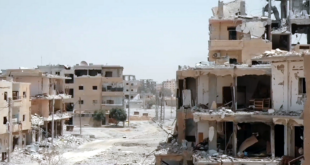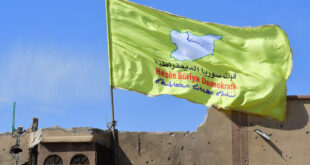
Hurras al-Din, affiliated with al-Qaeda in Syria, claimed responsibility for an attack against a Russian base in northern Raqqa and pledged to expand operations outside its areas of deployment in Idlib.
The Hurras al-Din (Guardians of Religion) group affiliated with al-Qaeda claimed responsibility for a recent attack on a Russian base in Tal al-Saman in the northern countryside of Raqqa, which is under the control of the Kurdish-led Syrian Democratic Forces (SDF).
The attack raised questions about Hurras al-Din’s ability to carry out attacks outside the areas of its deployment in Idlib, northwestern Syria. Some wondered about the timing of this attack and the messages the group wants to convey to the various parties that share control over the Syrian territory, including Hayat Tahrir al-Sham (HTS) that controls Idlib.
A car bomb targeted the Russian base near the village of Tal al-Saman on Dec. 31. A campaign dubbed “Raqqa Being Slaughtered” published photos on Facebook from the site of the bombing, noting that clashes with automatic weapons briefly broke out after the bombing without specifying the parties involved.
The Russian forces had strengthened their military presence at the Tal al-Saman base during December 2020 following an agreement with the SDF. The Russian TASS news agency quoted the deputy director of the Russian Khmeimim air base in Syria, Maj. Gen. Vyacheslav Sitnik, as saying on Dec. 27 that additional Russian military police units have been deployed to the Ain Issa area “to step up efforts to stabilize the situation.”
After the attack on the Russian base, Hurras al-Din issued a statement on social media it called “The Battle of Hardship,” saying, “A secret group from Hurras al-Din managed to raid a hub of the occupying Russian forces in Tal al-Saman in Raqqa governorate.”
Hurras al-Din leader Mohammed Abu Khalid al-Suri defined the objectives of the operation on his Telegram account, saying, “The mujahedeen believe that their goal in al-Sham (the Levant) is to fight the aggressive enemy, not the Muslims, nor is it to fight over the crossings, money and control, as warlords do.”
He added, “With the Battle of Hardship, the mujahedeen aim to prove a point to those factions that possess tens of thousands of soldiers, millions of dollars, weapons and equipment,” in an indirect reference to the opposition factions and to the HTS, which Hurras al-Din opposes and accuses of treason.
Suri added, “Targeting the bases of the Syrian regime and the Russian enemy and draining them is one of the most successful and most effective solutions in this period after the factions in the north closed the fronts, prevented invasions, concluded a truce with the enemies, and brought them into Muslim areas and dismantled the strength of the mujahedeen. We had to think outside the box to find proper solutions, which is why operations behind enemy lines were carried out to emphasize the mujahedeen’s rejection of imported international agreements.”
Bilal Sattouf, a researcher in jihadist groups residing in the countryside of Aleppo, told Al-Monitor, “The Hurras al-Din’s attack on the Russian base outside the Idlib area carries several indications. First and foremost, it reveals a security defect in SDF-controlled areas in a way that enabled the group to carry out this operation. It also indicates Hurras al-Din’s intent to expand the scope of its operations in Syria. In the future, we may witness other operations by the group outside Idlib against the Syrian regime forces and perhaps the Iranian militias, and the SDF as well.”
Sattouf added, “The attack also shows the differences between Hurras al-Din and HTS when it comes to ending the battles in Idlib, since HTS is somewhat committed to the Russian-Turkish agreement in Idlib. Meanwhile, Hurras al-Din wants to showcase itself as a large and effective force capable of shuffling the cards.”
He noted, “[The attack coincided] with Russian-Turkish action in Ain Issa aimed at deporting the SDF from the area. It seems Hurras a-Din wanted to prove its presence in the areas where other parties conclude agreements to share lands. Hurras al-Din also wants to tell both Russia and Turkey that the pressure exerted on the organization in Idlib could not eliminate it.”
Sattouf pointed out, “Hurras al-Din can reach areas outside Idlib, and the recent attack also provides it with jihadist propaganda that helps it preserve its jihadists as well as attract new ones, especially in light of the growing operations of the Islamic State (IS) in the Syrian desert, creating competition between the two organizations to attract jihadist fighters.”
HTS launched a campaign against Hurras al-Din in Idlib in 2020, which led to direct clashes and resulted in dismantling a large percentage of the organization amid internal divisions. Ever since, there have been questions on whether the clashes between HTS and Hurras al-Din pushed the latter to reconcile with IS, or even if the two (IS and Hurras al-Din) cooperated to strike the Russian base in Raqqa. This could be possible given that IS has been active in eastern and northeastern Syria, which could lead to cooperation between Hurras al-Din and IS in future attacks.
Orabi Abul-Hayy Orabi, a researcher in Islamic groups, told Al-Monitor, “I completely rule out the possibility of Hurras al-Din coordinating with IS to attack the Russian base. But there could be some sort of temporary truce between the two sides to facilitate their movements in the desert and other Syrian areas where the two sides have security cells.”
For his part, Obadah al-Tamer, dean of the Faculty of Political Sciences at the Damascus University in the countryside of Aleppo, told Al-Monitor, “Hurras al-Din’s attack may be linked to what might be called the proxy conflict over that area, but one operation may not be significant enough to base a logical explanation on, nor does it allow for a realistic prediction of causes.”
 Eurasia Press & News
Eurasia Press & News



